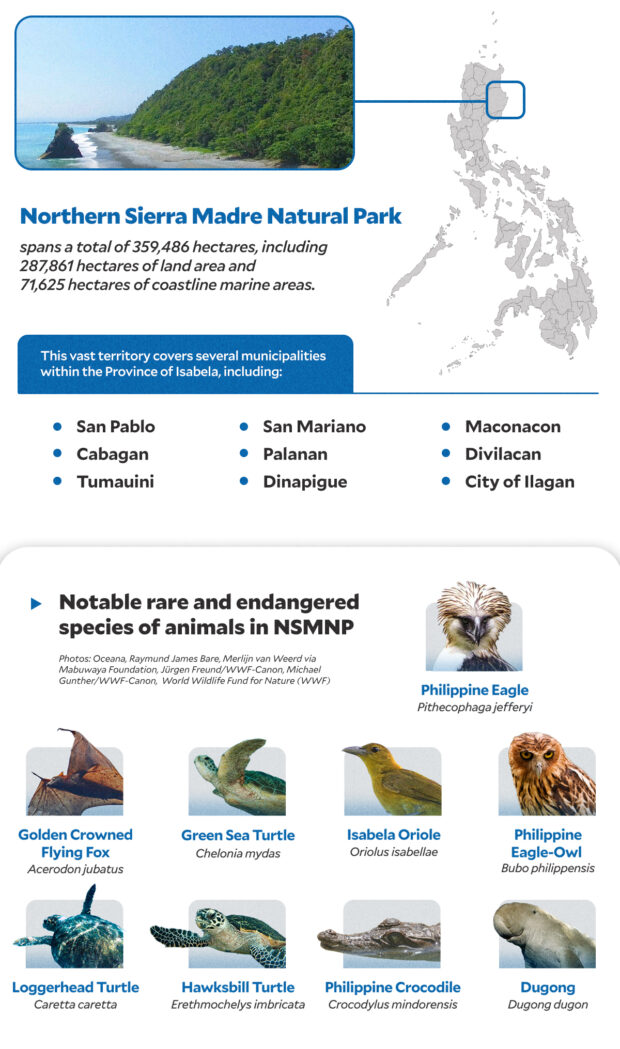Oceana lauds plastic ban in Sierra Madre protected area
MANILA, Philippines — An international ocean protection and conservation group lauded recent efforts to ban single-use plastics in Northern Sierra Madre Natural Park (NSMNP), the largest protected area in the Philippines, a significant step in addressing the escalating plastic crisis in the country’s protected areas.
Earlier this week, Oceana, a renowned marine conservation organization, commended the Protected Area Management Board (PAMB) of NSMNP in Isabela for adopting PAMB Resolution No. 12, a groundbreaking order that marks a critical step in preserving one of the country’s most vital protected areas.
Under the resolution, the sale, distribution, or retailing of products in single-use plastics — including bags, straws, cutlery, stirrers, and Styrofoam — are banned. This applies to all commercial and business establishments within NSMNP’s land and coastal areas.
“The PAMB of NSMNP finds it imperative to curb plastic pollution to shield our marine ecosystems and wildlife resources in the park from the persistent negative impacts of plastics,” said Director Gwendolyn Bambalan, regional executive director of the Department of Environment and Natural Resources (DENR) and PAMB chair.
“With the prevention of [the] sale of products wrapped in single-use plastics, we can better manage the plastics that encroach on our land and waters and encourage our people to protect our very own Sierra Madre Park by avoiding unnecessary single-use plastics,” Bambalan added.
Article continues after this advertisementNSMNP was established as a protected area by Republic Act No. 9125 of 2001 and in accordance with the National Integrated Protected Area System of 1992 as amended by Republic Act No. 11038, also known as the Expanded National Integrated Protected Areas System Act of 2018.
Article continues after this advertisement“This is a compelling stride towards the protection and preservation of the rich biodiversity of NSMNP,” lawyer Gloria Estenzo Ramos, vice president of Oceana, said in a statement.
“We are pleased about this huge development and commend the PAMB and the stakeholders for taking this bold step to reduce single-use plastics because this will not only benefit NSMNP’s flora and fauna, with several species considered endangered, but also the communities surrounding the area,” she continued.
Ramos also pointed out that the adoption and reinforcement of local ordinances by the nine local government units (LGUs) comprising the protected area are expected to implement the PAMB resolution and RA 9003 strongly.
According to Oceana, NSMNP is the latest protected area to enact a ban on single-use plastics within its boundaries.
This follows in the footsteps of Tubbataha Reefs Natural Park and Apo Reef Natural Park, which have already implemented similar regulations to prohibit single-use plastics for visitors, residents, and businesses operating within these marine protected areas.
READ: Oceana lauds single-use plastic ban in Tubbataha Reefs Natural Park
‘The Last Great Forest’
Dubbed “The Last Great Forest,” NSMNP stands out as a cornerstone in the Philippines’ conservation efforts, recognized for its unparalleled genetic, species, and habitat diversity. It is among the country’s top 10 priority protected areas due to its critical ecological value.
Spanning a total of 359,486 hectares, NSMNP includes both terrestrial and marine zones, stretching over 287,861 hectares of land and 71,625 hectares of coastal areas.
The vast territory covers several municipalities, including San Pablo, Cabagan, Tumauini, San Mariano, Palanan, Dinapigue, Maconacon, Divilacan, and the City of Ilagan, all within the province of Isabela.
Oceana noted that beyond its ecological significance, NSMNP plays a vital role in supporting human life.
“NSMNP’s various ecosystems provide fresh water for irrigation and domestic uses and food. It also serves as [a] barrier to flooding for some 56,000 people who live within and adjacent to the park,” the group said.
READ: Microplastics: Why we now already breathe, ingest killer plastics
READ: Filipinos losing war against single-use plastics – DENR
Home to rare and endangered species
According to the United Nations Educational, Scientific and Cultural Organization (Unesco) the NSMNP’s significance is highlighted by its role as a sanctuary for a diverse range of rare and endangered species of plants and animals.
Notable inhabitants include:
- Philippine Eagle (Pithecophaga jefferyi)
- Golden Crowned Flying Fox (Acerodon jubatus)
- Philippine Eagle-Owl (Bubo philippensis)
- Isabela Oriole (Oriolus isabellae)
- Green Sea Turtle (Chelonia mydas)
- Loggerhead Turtle (Caretta caretta)
- Hawksbill Turtle (Erethmochelys imbricata)
- Philippine Crocodile (Crocodylus mindorensis)
- Dugong (Dugong dugon)
“The mountain range system provides the area for growth and development of unique habitats and their associated flora and fauna, e.g., grasslands to mountain forests, which is among the most unique and richest on a per area basis among the park systems in the Philippines,” Unesco noted.
“It is described as [a] long mountain chain providing habitats for the numerous species of plants and animals adapted to various ecological niches,” it added.
More importantly, NSMNP is a critical refuge for many endemic and rare plant species. This includes members of the dipterocarp family such as Shorea spp. and Hopea spp., a variety of orchids such as Dendrobium aclinia, the leguminous tree Milletia longipes, and Swinglea glutinosa, a member of the citrus family.


